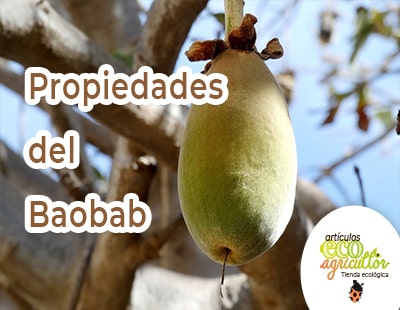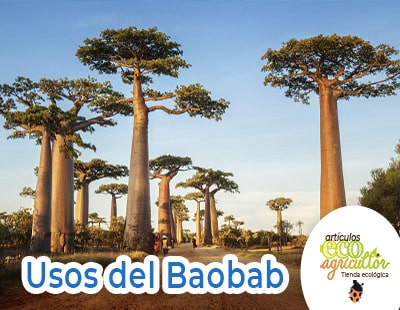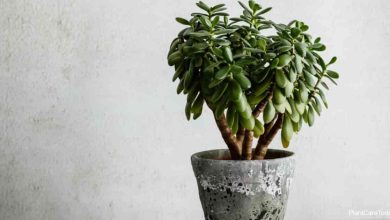Baobab, discover the medicinal properties and uses of this tree

For muscle tiredness and fatigue, taking care of hair, inflamed gums, for allergies, fever, high blood pressure …. The Baobab is a wonderful tree whose roots, bark, leaves, seeds and oil are used to naturally take care of health against a multitude of ailments.
The nutritional and medicinal qualities of Baobab remind us of the prodigious Moringa (known as the tree of life ).
If you want to know everything that is most important about this magical tree, in this article we will reveal the most extraordinary facts that you cannot miss without knowing.
What is Baobab?
The baobab ( Adanzonia digitata ) is a famous, although not widely distributed, species of trees of great size and spectacular shape, also called «Tree planted upside down», for its shape, «wooden elephant» or «vegetable elephant», for its great size, or «Magic Tree», for its multiple uses.
It is a native species of the semi-arid regions of sub-Saharan Africa, whose specimens are usually found isolated from each other, and can reach 30 meters in height.
Its characteristic trunk can reach 20 meters in diameter and store from 6,000 to 100,000 liters of water inside. Both its trunk, as well as leaves and fruits, are used for nutritional and medicinal purposes , as well as for multiple activities.
There are 8 species of Adansonia , one of them ( A. gibbosa ) is found exclusively in the Northwest of Australia, and another six are endemic to Madagascar, but the most numerous and widely distributed is A. digitata , or African baobab.
It is a tree that normally lives for about 500 years and can live for more than 5,000 years.
Its leaves are large and webbed, and its whitish flowers open only at night. Its fruit is an oval-shaped capsule that measures between 10 and 45 cm, with a hard and woody shell that contains many seeds embedded in a dehydrated pulp composed of small floury agglomerations with a slightly citric flavor.
Fruits and leaves are the parts most commonly used as food, but their bark and roots also have important medicinal properties .
Its leaves are consumed cooked or in soup, being a staple food in many populations of Sub-Saharan Africa. The pulp of the fruit is eaten fresh, it is extracted from the fibers and seeds by kneading them in cold water, the emulsion of which is sieved, or mixed into different preparations.
Baobab pulp and leaf production relies almost entirely on trees that grow naturally in forests or fields from local farmers. As with other non-domesticated species, there is great variability in characteristics between individual wild trees in different regions, including morphological traits and nutrient content of pulp, seeds, and leaves.
For this reason, it is important to know the origin of the Baobab products that we buy, making sure that the conditions of sustainability in production are guaranteed and include their nutritional information.

Composition and nutritional value of Baobab
Various parts of the plant have antioxidant, anti-inflammatory, antimicrobial, antiviral, antihepatotoxic, antidiarrheal, and trypanocidal (a group of parasites) properties.
Depending on the composition of each of these parts of the Baobab, they are used in different traditional uses.
-
Baobab leaves
They contain between 13 and 15% protein, 60 to 70% carbohydrates, 4 to 10% fat and around 11% fiber , providing an energy value of around 450 kilocalories of which 80% it is metabolized energy.
They are rich in pro-vitamin A and vitamin C, and have 5 of the 8 essential amino acids. They are a significant source of plant protein and minerals (especially iron ), as well as providing a slimy consistency to traditional local dishes such as soups and stews.
-
Baobab pulp
It contains 8.7% moisture with 2.7% vegetable protein , 0.2% fat, 73.7% carbohydrates and 8.9% fiber, with an energy value similar to that of leaves.
It is well known for its very high vitamin C content, which can reach up to 10 times that of orange .
Sweetness is provided by the high content of fructose, sucrose and glucose, while the acid taste is due to the presence of organic acids that include citric, tartaric, malic, succinic and ascorbic acid (vitamin C), also providing minerals such as calcium , iron and magnesium .
-
Baobab seeds
They contain 33.7% protein, 30.6% fat, 4.8% carbohydrates and 16.9% fiber. The energy value is approximately 50% higher than that of the leaves.
They are used as thickeners in soups and are fermented as flavoring agents. They are also roasted to use as a coffee substitute or eaten in sandwiches.
-
Baobab seed oil
They contain 73.1% unsaturated fatty acids and 26.9% saturated, with high proportions of linoleic acid (39.4%) and oleic (26.7%), as well as palmitic and alpha-linolenic acid.
They have been used for centuries by local communities for medicinal, food, and cosmetic applications .

What is Baobab good for
Many studies show that the pulp of the Adansonia digitata fruit is rich in vitamins and minerals, as well as containing a large amount of soluble and insoluble dietary fiber. The vitamin C content contributes to its high antioxidant capacity , as well as certain flavonoids and tannins.
In traditional medicine, the pulp of the fruit and the powdered seeds of the baobab are used in cases of dysentery and to promote perspiration.
The bark, for its part, is considered a cardiac tonic that also has diuretic properties .
The oils from the seeds are used in local traditional medicine for the topical treatment of muscle spasms , varicose veins and wounds , as well as for hair care .
The leaves and pulp of the fruits are used as an antipyretic. The powdered leaves are prepared for anti-stress and anti-fatigue treatments , as well as to relieve insect bites and as a tonic.
Also in traditional medicine , roasted and crushed seeds are used to soothe diseased teeth and inflamed gums ; In some regions, a decoction of the bark is also used as a rinse to clean diseased gums.
Studies have confirmed that the bark has anti-hemorrhagic, diaphoretic, antipyretic and anti-ophthalmic properties, verifying that an ethanolic extract of it improved the contractions of the heart muscles in rats and one of its glycoside components is an antioxidant with anti-cancer properties , anti-HIV and antibiotics.
Studies confirm that leaf preparations also have hypotensive, antihistamine, soothing and emollient effects , while the pulp of the baobab fruit acts as a palliative for fevers and dysentery.
Some experiments in rats also showed that the fruit pulp has a marked anti-inflammatory effect and analgesic and antipyretic activity , due to the presence of sterols, saponins and triterpenes.
Tests have also shown that the pulp of the fruit could be used to treat sickle cell anemia . Due to tannins, mucilages, citric acid and cellulose, it can be effective against diarrhea, and has prebiotic effects , due to soluble dietary fibers, stimulating the growth and metabolic activity of beneficial organisms in our intestines.
The fruit, seed and leaf extracts are antimicrobial against Bacillus subtilis, Escherichia coli, Mycobacterium leprae, and antifungal against Penicillium crusto-sum, Candida albicans and Saccharomyces cervisiae.
The essential vitamins (B1 and B2) present in the fruit pulp are important for the integrity of the cells, the nervous system, the eyes and the skin. Vitamin B3 (niacin) is essential in metabolic functions and vitamin B6 (pyridoxine) is involved in the production of substances that regulate mood.
The amount of vitamin C in the pulp of the baobab fruit reaches 300 mg per 100 g, so with only 25 to 30 g it would reach the recommended daily amount (75 mg for women and 90 mg for men). The antioxidant action of vitamin C protects cells from free radical damage, in addition to helping the absorption of iron and calcium. Vitamin C deficiency can cause scurvy and weaken the immune system promoting susceptibility to disease.
For its part, vitamin A is essential for the maintenance of cellular integrity and, together with the previous ones, favors the synthesis of melanin.

In summary….
In particular, the pulp of the baobab fruit is studied as a functional food and an important element for cosmetic use due to its properties:
- Antioxidant : promoting cell regeneration, preventing aging and diseases.
- Anti-inflammatory : reducing muscle inflation due to injuries, arthritis, osteoarthritis, etc.
- Analgesic : reducing pain.
- Antimicrobial : helping to eliminate or inhibit the growth of microorganisms such as bacteria and parasites.
- Prebiotic : promoting the growth of beneficial bacteria for intestinal protection.
- Source of vitamins and minerals : which contribute to general well-being and mood.
Possible contraindications of Baobab
The recommended daily amount is established between 5 and 30 grams of baobab fruit pulp (a maximum teaspoon to a tablespoon), which can be diluted in liquids, such as juices, water, yogurt or other preparations.
The pulp is negative for the most common allergens, and there have been no conclusive studies on the sensitivity to its components. However, there are some concerns about some fatty acids, especially baobab seed oils, which could be harmful.
It is recommended not to exceed the indicated doses and avoid its use during pregnancy or lactation, since there is no conclusive scientific evidence regarding its use in these situations or excess consumption, as well as interactions with specific medications.
Consulted bibliography
- «Baobab Tree ( Adansonia digitata L) Parts: Nutrition, Applications in Food and Uses in Ethno-medicine – A review», Zahrau Bamalli, Abdulkarim Sabo Mohammed, Hasanah Mohd Ghazali and Roselina Karim. Department of Food Science, Faculty of Food Science and Technology, Universiti Putra, Malaysia. Annals of Nutritional Disorders & Therapy, Vol 1, Issue 3. 2014
- «Descriptors for Baobab ( Adansonia digitata )», Kehlenbeck K., S. Padulosi and A. Alercia. Biodiversity International and World Agroforestry Center. 2015.
- «Baobab, the African super fruit of well-being», Todo Salud, Biological Institute of Health. 2011
- “Market Brief in the European Union for selected natural ingredients derived from native species. Adansonia digitata Baobab ”, Dr. Joerg Gruenwald and Dipl. Ing. Agr. Mathias Galizia. United Nations Conference on Trade and Development. 2005

![Photo of Acerola: [Cultivation, Irrigation, Care, Pests and Diseases]](https://www.complete-gardening.com/wp-content/uploads/2021/06/Acerola-390x220.jpg)
![Photo of How to Fertilize Apple Tree: [Dates and Ways to Do It]](https://www.complete-gardening.com/wp-content/uploads/2021/06/manzano_1583936813-390x220.jpg)
![Photo of Heliotrope: [Cultivation, Irrigation, Associations, Pests and Diseases]](https://www.complete-gardening.com/wp-content/uploads/2022/08/heliotrope-cultivation-irrigation-associations-pests-and-diseases-390x220.png)
